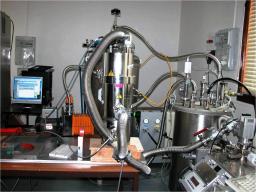
View of the closed and operational AGATA shunt connected to the pumping stations via the tubes shown in the foreground and to the cooled heat exchangers on the right. The helium compressor and liquid nitrogen tank can be seen in the background.
The Advanced Gamma Tracking Array (AGATA) is a roaming detector intended for use on all new European nuclear physics installations, including Spiral 2, FAIR, and Eurisol.
The 180 germanium crystals in the AGATA detector will be housed in 60 individual cryostats, each of which is fitted with a reserve tank containing a few liters of liquid nitrogen. As these crystals are not able to withstand vibration or temperature variations, it is necessary to halt the measurement process while the liquid nitrogen tanks are being refilled. The purpose of the connection shunt is to enable the individual cryostats to be connected to, and disconnected from, a silent cold source at 77 K, allowing the detector to operate continuously. A helium heat pipe links a remote liquid nitrogen bath to the crystals.
Tests on the device were carried out between 2007 and 2010 using the helium loop built by the Institute of Nuclear Physics (IPN) in Orsay. The initial tests confirmed the satisfactory thermal behavior of the shunt, and the ability to connect and disconnect at 77 K without heating the crystal beyond its operating limits. The next two test campaigns confirmed the possibility of operating the crystal continuously using a remote cold source without damaging the crystal. However, the resolution results, while greatly improved by modifications made to the system, are still not as good as those initially obtained using an individual crystal in its own liquid nitrogen bath. Being so close to success, consideration is being given to repeating the final series of measurements between now and the end of 2010 in order to finalize this process.

